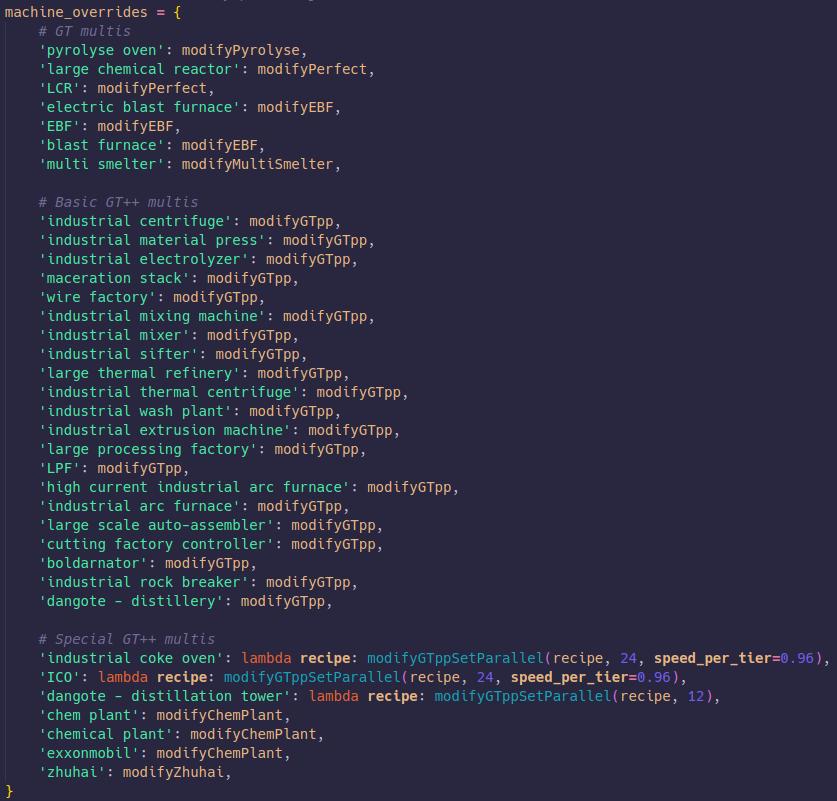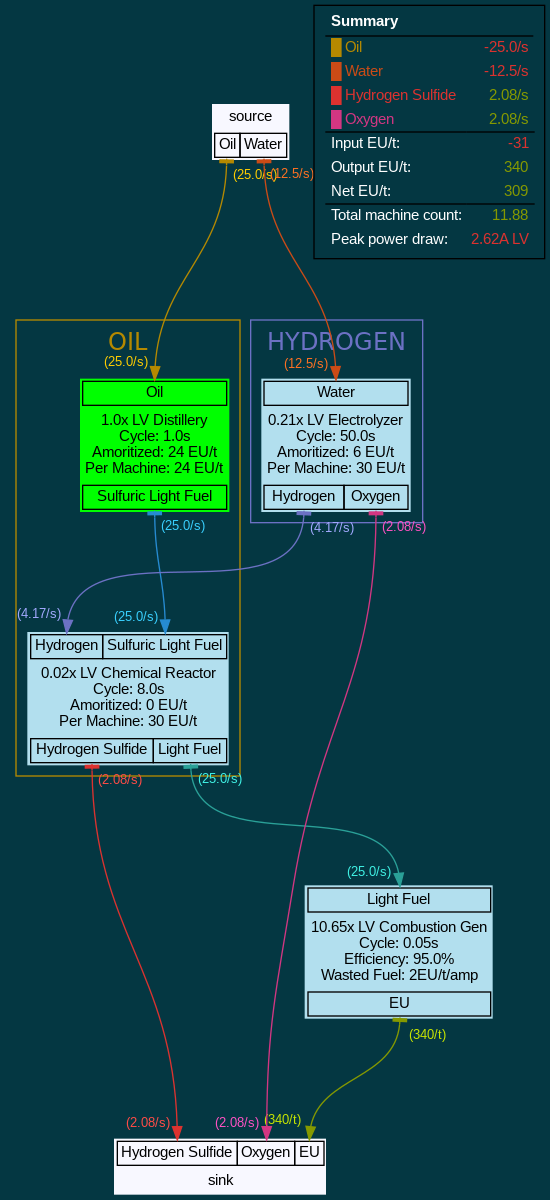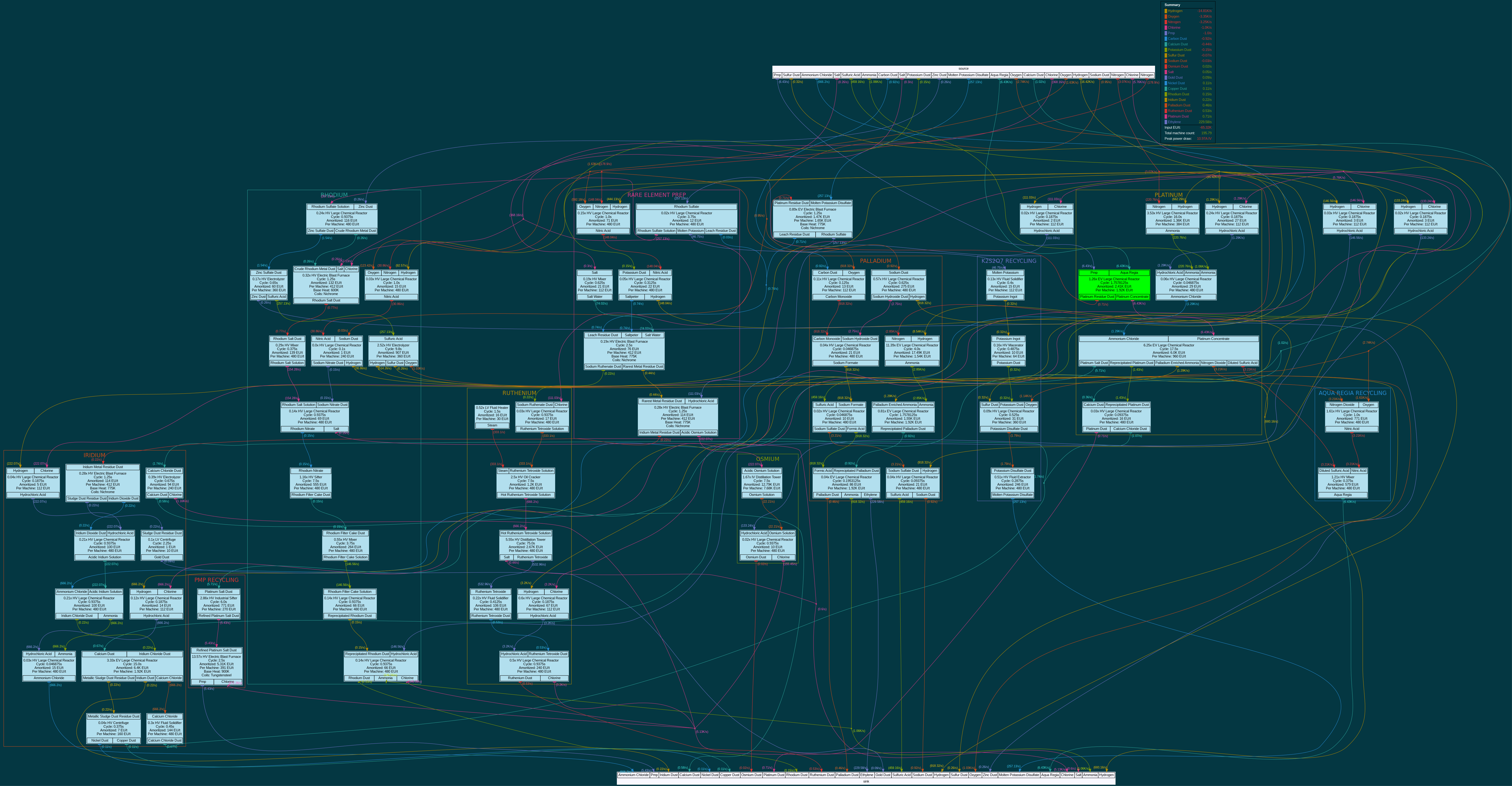A tool designed for complex GT packs. In specific, aims to achieve:
- Quick comparisons of power lines - which ones are "better" in terms of build difficulty, output, I/O efficiency, etc.
- Showing complex processing lines clearly all in one diagram (eg platline, petrochem, rare earths, etc)
- An easy standard tool for making balancing decisions
- Quickly prototyping weird ideas or swapping out different parts in a complex machine line
It achieves this by automatically doing machine balancing math for you. You define a machine process once, then you can modify total system I/O or overclocks by only changing a few lines, and gtnh-flow will recompute everything in seconds. Outputs are given visually in either png or pdf (searchable!) format using graphviz.
- Clone repository (
git clone https://github.com/OrderedSet86/gtnh-flow.git) - Download Python and dependencies (
pip install -r requirements.txt) - Graphviz is an external library and will need to be downloaded separately (on Debian-based Linux this is
sudo apt-get install graphviz)
(The next steps will ask you to run some commands - use Powershell or WSL for this.)
- Clone repository
git clone https://github.com/OrderedSet86/gtnh-flow.gitor download it using Code (green button) -> Download ZIP on Github, then unzip. - Download Python 3 and install from
https://www.python.org/downloads/windows/.pip --versionandpython --versionshould both return valid version numbers from the command line. Python should be version 3. - Navigate to the cloned git repository in a command prompt and install the Python dependencies
pip install -r requirements.txt - Graphviz is an external library and will need to be downloaded separately. The graphviz maintainers have a guide:
https://forum.graphviz.org/t/new-simplified-installation-procedure-on-windows/224. It is important that Graphviz is added to the System PATH for either all users or current users and you may need to restart Windows for this change to take effect.
- Create a project file under
projects/. You can look at existing projects to see how to structure it. Inflow's current form, you need to specify exact I/O and eut/duration in seconds, as well as which voltage you wish to actually run the machine at (for calculating overclocks). In addition, at least one machine will need anumberortargetargument to be specified, which tells the program how to balance the rest of the machines in the network. (The green nodes in the example above are thenumbered nodes.) - Run the project by name using
python factory_graph.py, then inputting whatever your project is called (eg "power/benzene/iv"). - Output graph will pop up and also be available in
output/!
The idea of gtnh-flow is to automatically do all the machine balancing math for you. But you need to specify at least one machine for the information to propagate out to the rest of the graph. Both "target" and "number" provide this information. Examples:
"number": 3means "there are exactly 3 of this machine""target": sulfuric acid: 1000means "there are exactly enough of this machine to produce 1000 sulfuric acid per second"
- You can modify a variety of layout and functional choices in
config_factory_graph.yaml. - The POWER_LINE feature in
config_factory_graphlets you automatically burn fuels and choose which ones to ignore. This is on by default. - When writing a config file, I recommend copy pasting an old machine, then editing the numbers. This will help you avoid missing any required fields (eg. EU/t).
- How to add machines without any power usage? Set "tier" to LV and "eut" to 0.
- Will this automagically handle overclocking for GT++ multis? Yes! All these names are recognized and will be overclocked automatically to 1A of the tier you select. Specifying the exact amount of power input is a planned feature, but not in the library yet.

- Sometimes the balancing algorithm will fail. This is explained in more detail in ## It's still beta. You may need to manually make adjustments to some shared ingredients to separate them from other machines. The easiest way to do this is is by renaming the ingredient slightly, like
chlorine 1andchlorine 2. This will cause it to no longer automatically be used in any machine that needs chlorine, just the one you want. You can see this technique used regularly for platline.
gtnh-flow cannot solve certain parallel edge product situations - this is hopefully being resolved in version 2, which is currently in pre-alpha development. It will take a while as I am trying to avoid the way Factorio solvers work, which is to define an "objective" value for every item in the game. This is impractical to do and permanently maintain for GTNH.

